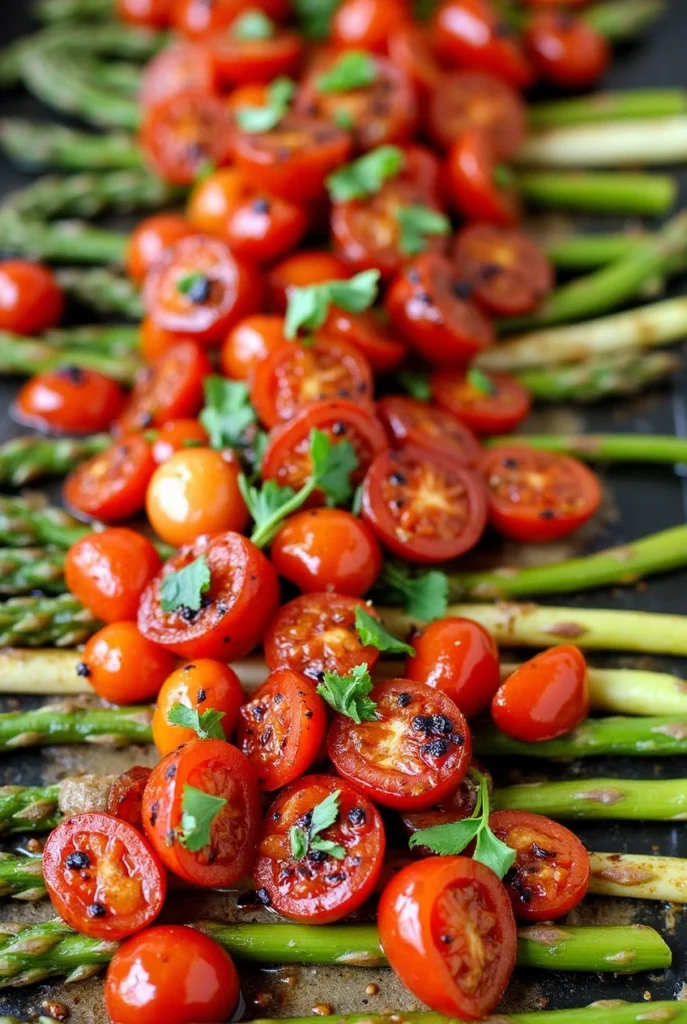The Balsamic Asparagus and Tomatoes dish is a celebration of fresh, seasonal ingredients that come together in perfect harmony. This simple yet vibrant recipe highlights the natural sweetness of asparagus and tomatoes, elevated by the rich tanginess of balsamic vinegar. Rooted in Mediterranean culinary traditions, this pairing has become a favorite among home cooks for its ease of preparation and bold flavors. Its versatility makes it an ideal choice for light dinners, spring gatherings, or as a side dish to complement grilled proteins.
Key Ingredients and Their Role
Asparagus: The Star Vegetable
Fresh, seasonal asparagus forms the backbone of Balsamic Asparagus and Tomatoes dish, offering a crisp texture and earthy flavor. Select spears with firm stems and closed tips for maximum freshness. Trim the woody ends and wash thoroughly before cooking. Whether roasted, grilled, or sautéed, proper preparation ensures tenderness without losing nutrients.
Tomatoes: Adding Sweetness and Color
Tomatoes bring sweetness and color to balance the savory asparagus. Cherry, grape, or heirloom varieties work best, each contributing unique notes. Halve or quarter them depending on size, then toss with olive oil, salt, and pepper for enhanced flavor. Roasting or grilling intensifies their natural sugars, creating a delightful contrast with the asparagus.
Balsamic Vinegar: The Signature Flavor
Balsamic vinegar adds depth and tanginess, tying the dish together beautifully. Aged balsamic offers complexity, while reduced versions create a sticky glaze. Traditional balsamic provides authentic richness, making it a versatile ingredient. Drizzle generously over the vegetables for an irresistible finish.
Optional Additions
To elevate the dish further, incorporate garlic for aroma, olive oil for moisture, or herbs like basil and thyme for fragrance. Nuts such as pine nuts or almonds add crunch, introducing additional textures and flavors that enhance the overall experience.
Step-by-Step Preparation Guide
Preparing the Asparagus
Begin by trimming the tough ends of the asparagus and rinsing under cold water. Choose your preferred cooking method roasting brings out smoky notes, grilling imparts charred undertones, and sautéing preserves tenderness. Season lightly with salt, pepper, and olive oil before cooking until tender-crisp.
Preparing the Tomatoes
Cut tomatoes into uniform pieces for even cooking. Toss with olive oil, salt, and pepper, then roast or grill alongside the asparagus. This step enhances their sweetness and juiciness, ensuring they complement the earthy asparagus perfectly. Adjust seasoning based on personal preference for balanced results.
Combining with Balsamic Vinegar
Drizzle store-bought balsamic glaze or reduce balsamic vinegar on the stovetop for a homemade version. Simmer gently until thickened, creating a glossy coating that clings to the vegetables. Combine all elements carefully, ensuring even distribution of flavors for every bite.
Final Touches
Garnish the dish with freshly torn herbs like basil or thyme for added freshness. Grated Parmesan cheese introduces a salty note that pairs beautifully with the sweetness of the tomatoes and asparagus. These finishing touches make the dish visually appealing and more flavorful.
Serving Suggestions and Pairings
Ideal Occasions for Balsamic Asparagus and Tomatoes
Balsamic Asparagus and Tomatoes shines during spring and summer meals when produce is at its peak. Serve it as a standalone light dinner, pair it with crusty bread for casual lunches, or offer it as a side dish alongside grilled meats. Its simplicity and elegance make it suitable for both everyday dining and special occasions.
Beverage Pairings
Pair the dish with crisp white wines like Pinot Grigio or Sauvignon Blanc, which highlight its fresh flavors. For non-alcoholic options, try sparkling water with lemon or herbal teas for a refreshing contrast. These beverages complement the dish’s acidity and vibrancy without overpowering it.
Creative Variations
Add feta cheese for a salty kick, pine nuts for crunch, or arugula for peppery freshness. These variations allow you to personalize the Balsamic Asparagus and Tomatoes dish according to your taste preferences, turning it into a unique culinary creation every time.
Nutritional Information and Health Benefits
Nutritional Breakdown
The Balsamic Asparagus and Tomatoes dish offers a balanced nutritional profile, with approximately 150-200 calories per serving. It contains healthy fats from olive oil, lean proteins from optional additions like feta, and carbohydrates from the vegetables. Practice portion control by pairing it with whole grains or lean proteins for a complete meal that satisfies hunger while promoting wellness.
Health Benefits of Key Ingredients
Asparagus and tomatoes are rich in antioxidants, supporting immune health and reducing inflammation. Balsamic vinegar adds probiotics when unfiltered, aiding digestion and gut health. Substituting ingredients like using extra virgin olive oil or skipping cheese can make Balsamic Asparagus and Tomatoes dish even healthier without sacrificing flavor.
Customizing for Diets
Balsamic Asparagus and Tomatoes dish is naturally gluten-free and vegan-friendly. For low-calorie adaptations, reduce oil usage or omit cheese entirely. These adjustments ensure it fits seamlessly into various dietary lifestyles while maintaining its delicious appeal.
Common Mistakes and Troubleshooting
Mistakes to Avoid
Avoid overcooking asparagus, which leads to mushiness, and choose high-quality balsamic vinegar for superior taste. Overcrowding the pan during cooking can cause steaming instead of caramelization, resulting in less flavorful vegetables. Stick to recommended quantities and techniques for optimal results.
Troubleshooting Tips
If the dish feels overly acidic, balance it with a pinch of sugar or honey mid-cook. Adjust seasoning as needed, tasting frequently to ensure desired flavors. For under-seasoned vegetables, sprinkle additional salt, pepper, or herbs before serving to enhance taste.
Salvaging Imperfect Results
Turn overcooked asparagus into purees or soups, adding depth to other recipes. If the dish lacks balance, incorporate more tomatoes or a splash of water to dilute strong flavors. Creative problem-solving ensures no effort goes to waste!
Variations and Customizations
Classic vs. Modern Twists
While traditional recipes focus on simplicity, modern adaptations introduce exciting elements like roasted garlic, chili flakes, or truffle oil. Experiment with different balsamic reductions or vinegars to personalize the dish according to your preferences, blending classic roots with contemporary flair.
Seasonal Variations
Incorporate seasonal produce for variety add peas or radishes in spring, zucchini or bell peppers in summer, or roasted squash in fall. These changes keep the Balsamic Asparagus and Tomatoes dish fresh and exciting year-round, allowing you to enjoy local flavors at their peak.
Global Inspirations
Add Mediterranean touches with olives, oregano, or capers, or explore Asian influences by incorporating soy sauce, ginger, or sesame seeds. Global inspirations bring new dimensions to the dish, expanding its versatility and appeal for adventurous eaters.
See Also:
- Healthy Chicken and Vegetable Skillet
- Healthy Chicken and Vegetable Skillet
- Amazing Mediterranean Cod with Tomato Basil Sauce
FAQs Section
Q: Can I use frozen asparagus?
A: Yes, but thaw and pat dry thoroughly before cooking to prevent excess moisture, ensuring crispness and flavor.
Q: How long does the dish last in the fridge?
A: Properly stored in an airtight container, it stays fresh for up to 3-4 days. Reheat gently to restore texture and warmth.
Q: Can I make it ahead of time?
A: Absolutely! Prepare and refrigerate; reheat just before serving for convenience without compromising quality.
Conclusion
The Balsamic Asparagus and Tomatoes dish combines fresh vegetables with tangy balsamic vinegar for a nutritious and flavorful experience. By avoiding common mistakes, troubleshooting issues, and experimenting with variations, you can craft your perfect version.
Dive into cooking today and enjoy the satisfaction of creating this simple yet sophisticated dish!
Savor responsibly and embrace the joy of homemade goodness with family and friends.

Balsamic Asparagus and Tomatoes
- Total Time: 20 minutes
- Yield: 4 servings 1x
- Diet: Vegetarian
Description
This Balsamic Asparagus and Tomatoes recipe is a simple yet vibrant dish that highlights the natural sweetness of roasted tomatoes and the earthy crispness of asparagus. A drizzle of rich balsamic vinegar ties everything together for a delicious, healthy side dish perfect for spring dinners, summer cookouts, or everyday meals.
Ingredients
- 1 lb asparagus, trimmed
- 1 cup cherry or grape tomatoes, halved
- 2 tbsp olive oil
- 1 tbsp balsamic vinegar (or balsamic glaze)
- 1 clove garlic, minced (optional)
- ½ tsp salt
- ¼ tsp black pepper
- ¼ tsp red pepper flakes (optional)
- Fresh basil or thyme for garnish
- 2 tbsp grated Parmesan cheese (optional)
Instructions
- Preheat oven to 400°F (200°C). Line a baking sheet with parchment paper.
- Toss asparagus and tomatoes with olive oil, balsamic vinegar, salt, and pepper. Spread evenly on the baking sheet.
- Roast for 12-15 minutes, or until asparagus is tender and tomatoes are slightly caramelized.
- Remove from oven and garnish with fresh herbs and Parmesan cheese (if using).
- Serve warm as a side dish or light meal. Enjoy!
Notes
- Use aged balsamic for a deeper, richer flavor.
- For a grilled version, cook asparagus and tomatoes on a grill pan over medium heat for 6-8 minutes.
- Add toasted pine nuts or feta cheese for extra texture and flavor.
- Prep Time: 5 minutes
- Cook Time: 15 minutes
- Category: Side Dish
- Method: Roasting
- Cuisine: Mediterranean
Nutrition
- Serving Size: ~150-200
- Sugar: 3g
- Sodium: 200mg
- Fat: 10g
- Saturated Fat: 2g
- Unsaturated Fat: 8g
- Trans Fat: 0g
- Carbohydrates: 10g
- Fiber: 3g
- Protein: 4g
- Cholesterol: 5mg (if using Parmesan)

